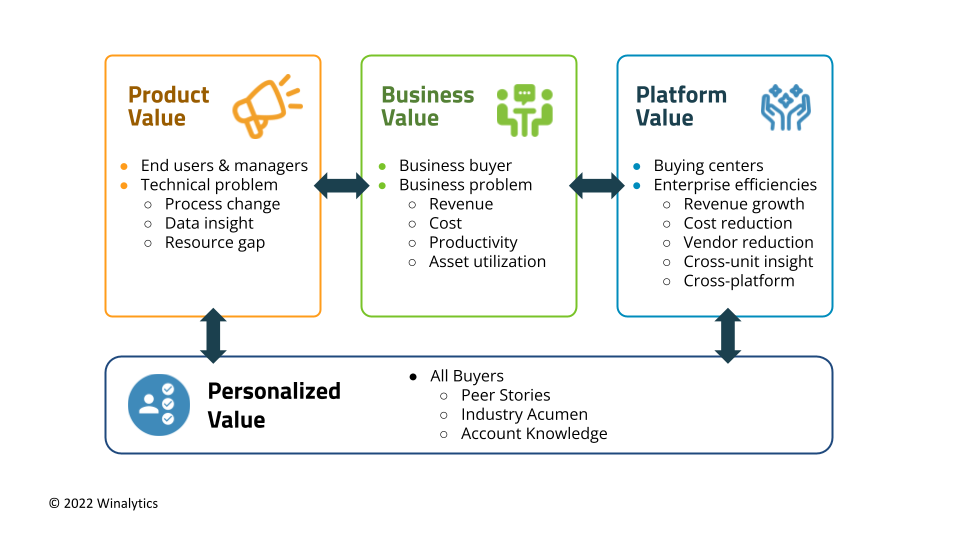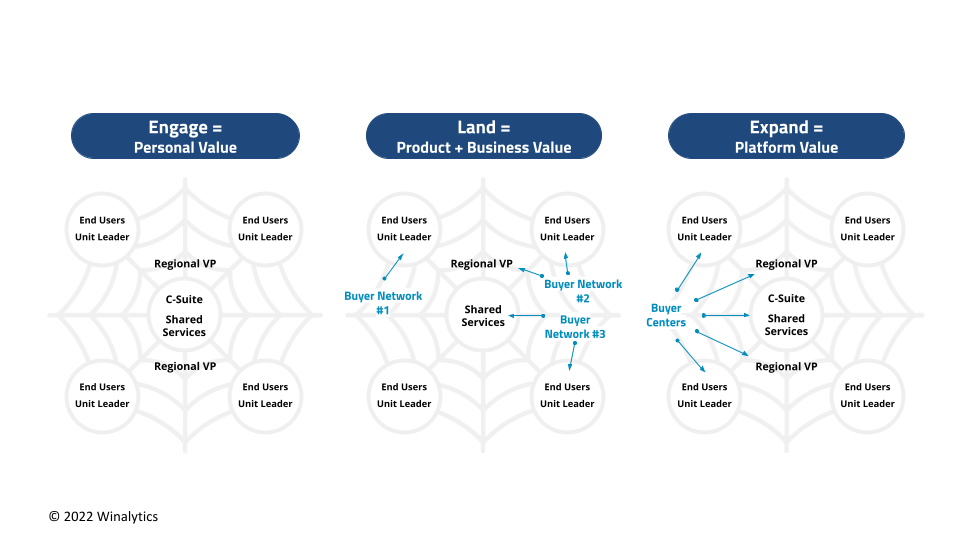A hyper-personalized buyer experience is usually associated with B2C companies and the consumer journey. No longer. It has become equally important for strong B2B growth.
Consider these recent studies on B2B buyer personalization:
- A Salesforce study found 72% of business buyers say they expect a similar experience on a B2B website as they get on a consumer website.
- A Demand Gen report found that 68% of B2B buyers want to see content organized by goal or issue and 92% give the most credence to reviews by industry peers.
- A McKinsey article found the companies that grow faster drive 40% more of their revenue from personalization than their slower-growing counterparts.
The single fastest way to bring your team into alignment around buyer personalization is to extend your account-based marketing (ABM) marketing from the traditional focus on marketing and early buyer engagement to create a holistic ABM strategy across your entire go-to-market team.
ABM is best known as a marketing strategy that uses personalized campaigns to engage multiple buyers and units within target accounts. Customer-centric companies, however, are using holistic ABM to connect marketing, sales, account management, and customer success to grow their revenue faster.
Moving from a traditional ABM strategy to a holistic ABM strategy requires two key adjustments. Marketing teams can lead on both but need CEO or COO sponsorship for cross GTM alignment.
The first adjustment is to agree on the four connected levels of buyer value—product, business, platform, and personalized value—that support not only initial engagement but also sales execution and account management. The second is to identify and align on buyer networks that can seamlessly connect initial engagement to landing an initial sale to expanding account value beyond the first sale.
A. Four Levels of Buyer Value
In a well-developed holistic ABM strategy, buyer value takes place at four levels:
- Product value helps front-line users or managers improve a process or workflow, address a resource gap, generate data insight, or change an employee or user experience.
- Business value comes from connecting those product outcomes to revenue, cost, productivity, or staff or asset utilization gains that can be used to justify a business investment.
- Platform value comes from repeating an achieved business outcome in several buying centers to build enterprise gains in revenue growth, cost savings, vendor reduction, cross-unit insight, and collaboration.
- Personalized value comes from connecting all three types of outcomes to all buyers’ specific industry issues, industry peers, and company-specific business goals and initiatives.

Making these four levels of value explicit reduces friction for your sales, account management, and customer success team members as they move buyers within a target account beyond initial engagement toward a meaningful conversation, a new sale, or expansion sale opportunity. The four levels of value make it easier for an internal buying group to talk to each other and align.
To take an example of connecting buyer value across these four levels, let’s look at Parsable. Parsable offers manufacturers a handheld, digital workflow application that improves the efficiency of production, maintenance, safety, productivity, and quality. By replacing thousands of paper-based work instructions with a digital workflow, Parsable’s application can guide shop floor behavior, build standard operating procedures at scale for hundreds of processes, and capture data to optimize those processes.
Line managers in production, quality, maintenance, and other areas care about product value and specific technical use cases. They want to see how Parsable can automate processes, checklists, and tasks that their team needs to complete day-to-day activities.
Plants managers and vice presidents responsible for a group of plants in a region think in terms of dollars and cents. They will be interested to hear how Parsable can shift quality inspections from manual to digital workflow, but they are a lot more interested to hear how this digital workflow can catch and correct persistent quality defects, reduce quality issues, and save millions of dollars.
C-suite executives and digital transformation teams that sit centrally are most interested in understanding enterprise transformation. They want to know how taking Parsable from one manufacturing plant to the next or one business use case to another can unlock enterprise efficiencies. Enterprise value might come from increasing revenue, reducing costs, eliminating legal and administrative costs of multiple vendors, or increasing business insight and time to decisions.
Finally, every single one of these buyers is going to want to hear how Parsable’s manufacturing workflow has contributed to product, business, or platform value with peers in their industry sector. Buyers in a consumer packaged goods company will be most interested to hear about Parsable’s impact at Heineken, Coca Cola, and Grupo Bimbo. Buyers in construction and building materials will be most interested in stories from CEMEX, CMC Materials, and Halliburton.
B. Aligning Buyer Networks Across the GTM Team
A typical ABM strategy might have 10 to 15 key personas, including end users and their managers, unit leaders, C-suite or executive buyers, and buyers sitting in central shared service offices. A traditional ABM strategy typically focuses on these buyers individually and stops with initial buyer engagement.
A holistic ABM strategy, by contrast, connects that initial buyer engagement to finding the right combination of buyers in a buyer network. It is not the individual buyer but the buyer network that matters the most in closing an initial sale, as well as finding follow-on expansion sales faster.

1. Engage with Personalized Value
In the initial engagement phase, traditional and holistic ABM strategies look very similar. Both types of ABM strategies use targeted messaging and outreach to more than a dozen personas.
When Parsable’s marketing and prospecting teams think about engaging a new account, for example, they are using targeted website pages and prospecting sequences to engage 12 to 15 buyers with what they value most.
Product, quality, safety, and maintenance managers are engaged with targeted use cases and peer stories focused on automating manufacturing processes, checklists, and tasks. Plant managers and regional VPs are engaged with peer stories and business outcome data that show Parsable can increase production efficiencies and reduce costs, unplanned downtime, and quality incidents.
C-suite executives and central digital transformation teams are engaged with stories about enterprise transformation at companies like Heinken, Georgia Pacific, Grupo Bimbo, and Corteva. The goal of reaching out to a dozen personas at once with peer stories and a personalized value prop is to create a web of buyer engagement across the enterprise.
2. Land with Product + Business Value
It is in the sales phase that a holistic ABM strategy starts to really differentiate itself from a traditional ABM strategy. In a holistic ABM strategy, buyers hear the same value messaging from the website, prospecting outreach, sales, and customer success conversations.
This consistency helps buyers and customers learn quicker the why and how of working with you. They show up to a first sales conversation better educated and better able to engage in a value-added conversation. The sales team is in a position to reinforce the same value messages and peer stories.
More importantly, a holistic ABM strategy also builds sales velocity by creating a shared, cross-GTM view on the right buyer networks to guide internal conversations. The holistic GTM strategy essentially offers the sales team a “cheat sheet” for the most likely buyer combinations to get to a first sale.
An initial sale typically is the result of connecting product value for a user or their manager to business value for an economic buyer with a budget. It sits with the sales team member to help the two internal buyers to make the connection between product and business value.
For most sales teams, there are three types of buyer networks that align product and business value:
Buyer network #1: Connects end users to a buyer with a budget in a single business unit.
Buyer network #2: Connects end users to a regional VP with a budget across business units.
Buyer network #3: Connects a central office with a budget to end users in one or more business unit(s).
Parsable uses all three types of buyer networks to land a new sale with a customer. They talk about connecting “a buyer with a problem to a buyer with money and power.”
For Parsable, buyer network #1 normally means connecting a production, maintenance, quality, and safety manager in an individual plant to the plant manager responsible for that plant’s production efficiency, costs, and quality.
Buyer network #2 is similar, but at a larger scale. For Parsable, it means connecting a regional business lead responsible for production, maintenance, quality, and safety managers across several plants to the regional vice president’s budget and key business initiatives.
Buyer network #3 for Parsable means engaging a Director or Vice President in central digital transformation offices to end users in a plant or region. The Director or Vice President of Digital Transformation who sees the platform potential is going to want to see demonstrated business value in specific initial use cases before considering broader enterprise application.
3. Expand on Platform Value
The strength of a holistic ABM strategy becomes even clearer in the account management and customer success phase.
A well-developed holistic ABM strategy means that the account management and customer success teams spend a lot less time having to educate or re-educate new buyer groups within an existing customer account. So, they can spend more time on expansion opportunities.
The web of engagement in the prospecting phase means that many other potential buyers are aware of a product or service. The focus on looking for different combinations of product + business value in the sales phase means that there may be a number of expansion deals that are already warmed up.
Because of these warm connections, the account expansion and customer success team have an easier time linking success to date around demonstrated business value to new units or use cases. Their goal is to create new buyer centers with a budget to expand on the demonstrated business value. These buying centers might include unit leaders, regional VPs, shared service offices, and the C-Suite.
At Parsable, the expansion opportunities pursued by account managers and customer success team members include all of these buyer centers. They take business value delivered by the initial use case to new plants or regions. They can take the success with an initial use to identify new use cases. They approach the digital transformation office or the C-Suite to support broader enterprise rollout.
The more buying centers that add Parsable, the larger the enterprise-wide gains in things like production efficiency or reduction in costs or quality incidents or improvements in cross-enterprise business insight and time to decision-making—as well as reduced costs of vendor management.
Many CEOs, COOs, and marketing teams think of ABM strategies as just for marketing purposes, particularly lead generation. By shifting to a holistic ABM strategy that extends across the entire go-to-market team, however, these leaders can drive faster revenue growth.
A holistic ABM strategy leads to more consistent value messaging to all target buyers, so buyers and customers are continually educated about why and how to buy from you. A holistic ABM strategy also accelerates revenue by connecting initial buyer engagement to a plan for the buyer network(s) that can land an initial sale and the buying centers to support expansion sales.



